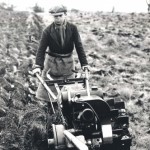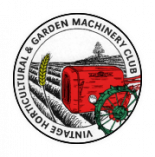Forum Replies Created
-
AuthorPosts
-
May 9, 2022 at 8:01 am #38989
 trusty220Keymaster
trusty220KeymasterHmmmmm, let’s see- loosely connected to Gunsmith? Would that be the BMB Plowmate?
May 8, 2022 at 6:53 pm #38982 trusty220Keymaster
trusty220KeymasterOK, lets have another picture then! I see you tried to upload a third one but it didn’t come out.
May 8, 2022 at 6:49 pm #38976 trusty220Keymaster
trusty220KeymasterI’ve spent most of the day on the Allett today. First off was to remove the grassbox and carrying brackets- I’ve got enough lumps on my shins from walking into Mastiff brackets so I’m determined not to add to the collection. Even the grassbox has had a lot of thought behind it so that the carrying bolts will act as pivots to empty it; the washers behind the bolts are stepped to provide a bearing surface on the carrying arms. I always thought that these mowers would be young enough to be made with UNF threads but all of the grassbox bolts and nuts are BSF. This theme was carried through to the thrower plate behind the cylinder, so I’m guessing that the whole mower is BSF throughout. Contrast that with the Reliant engine which seems to be UNF so far and it means that I’ve got most of my toys out of the box. I haven’t come across any metric threads yet but I won’t make any rash predictions at this stage.
First major target for the day was to get the engine running properly, so off came the carburettor for a thorough clean inside and out. I always find that brake cleaner works the best on baked-on dirt on the outside but in this case it was that stubborn I had to soak it in a bath of petrol then rub it with fine wire wool. Several applications later it was good enough to pass muster so I started putting it back together; luckily there was nothing really wrong with it and the excess fuel causing the engine to run too fast was down to the choke assembly sticking inside the body of the carb. The actuating arm on the outside was in the correct position but the internal mechanism is pushed back to the “off choke” position by a spring- this was stuck with debris, so a good clean achieved the desired result.
In order to remove the carb. it was necessary to take off the rocker cover so that I could reach the nut on the inside of the flange. Whilst the cover was off I took the time to address the rattling tappets. The gaps varied between 6 thou and 12 thou in no particular order, so they were all adjusted to 8 thou as recommended by Roy Allett. He really is a mine of information and when he called me on Friday he gave me quite a few pointers from the time he used to make and market these machines. Apparently the factory used to remove the thermostats from the engines as well and block the bypass hose with a cork to improve the flow rate through the tiny radiator to prevent overheating in the summer months. This is something we used to encounter with some of the Ransomes machinery if lazy operators didn’t keep the radiator screens clear of grass cuttings, so I can entirely relate to his comments!
Anyway, all put back together and I fired the engine up again. The rattling had almost disappeared completely and once the engine reached operating temperature the choke was pushed in and the revs dropped down to an acceptable level. With a few adjustments a lovely slow and even tick-over was achieved, so target achieved and a well-earned beer downed!
May 8, 2022 at 6:14 pm #38974 trusty220Keymaster
trusty220KeymasterOur local farm supplies, TFM Machinery, sells Tractol enamel. The green that I used on the toolframe was labelled as Ransomes Green but it is the old shade that they used up to the mid-eighties. It’s a little lighter than the current shade of green that Ransomes use but I thought I’d use it to show up the toolframe better.
Thanks for the kind comments.
May 8, 2022 at 6:09 pm #38973 trusty220Keymaster
trusty220KeymasterHi, John. Those wheels look like Gunsmith. Am I right?
May 6, 2022 at 4:56 pm #38960 trusty220Keymaster
trusty220KeymasterThat was exactly what I was going to do- leave it alone! When I was running it the other day the only adverse noises that I could hear were an excessive tappet noise. Roy Allett says that one of the service mods done on them during their working life was to set inlet and exhaust valves both to 8 thou. I will investigate over the weekend and let you know what they are at present!
May 6, 2022 at 6:18 am #38957 trusty220Keymaster
trusty220KeymasterThe engine block is cast aluminium and has “Reliant” cast into it, but I’m hoping that I can source various parts from Mini suppliers. It will need a full set of radiator hoses as well as an engine oil filter so I’m hoping that the original builders used commonly available items.
After talking briefly to Roy Allett he informed me that the engine block has wet liners, so I’m going to have to be careful not to let the internals of the block dry out or I risk the liner seals leaking into the sump.
Next on the agenda is a carburettor clean. That will be this weekend and then I should hopefully get the tick-over speed down to something approaching normal. Wish me luck!
May 4, 2022 at 8:49 pm #38944 trusty220Keymaster
trusty220KeymasterIt lives! After a considerable amount of time and swearing the engine finally burst into life this evening. If I were to paraphrase Eric Morecombe, all the parts were there but not necessarily in the right place; the ignition coil took it’s live feed off the positive side of the starter solenoid which meant that the coil was live at all times even with the key turned off. The wire used was taken off and it was just the right length to reach to the correct terminal on the back of the ignition switch, so I’m guessing it was part of the original wiring loom. The way it was wired up would prevent anyone turning the engine off and it would have been a fire hazard, so it was indeed lucky to survive!
The ignition coil was only the first step, unfortunately. The live feed was traced as far as the contact breaker points before it vanished. Luckily the engine has a Lucas distributor; my GT6 also has a Lucas distributor, so looking in the stock I carry for it I managed to come across a brand new set of points complete with all of the insulating washers and bushes. The old points had one insulator missing which had the result of connecting both sides of the points to earth, which effectively meant that there was no spark at the plugs. Once put back to how it should have been in the first place the engine fired up and ran. The only thing now is that it will not idle even though the throttle butterfly is closed, so the carburettor is going to have to come apart.
Onwards and upwards, at least it’s coming together.
-
This reply was modified 3 years, 4 months ago by
 trusty220.
trusty220.
May 4, 2022 at 4:44 pm #38933 trusty220Keymaster
trusty220KeymasterHere are some pictures that I took of the mower whilst it was still at the factory. For it’s age it is in remarkably good condition and definitely needs preserving rather than restoring. A certain amount of paint re-touching will be necessary and the skill will be in blending it in with the existing paint.
May 1, 2022 at 4:02 pm #38918 trusty220Keymaster
trusty220KeymasterI’ve just been clearing out the workshop ready for the next project which is due to arrive on Wednesday. In case you were wondering what had happened to the Trusty rebuild, here are some photo’s I took earlier today before I unloaded it at the farm. The depth wheel isn’t fitted as it won’t go high enough to allow the wooden trestle to fit under the front of the chassis so off it came for now.
The next project is NOT a Trusty so you can breathe freely again. I’ll give you a clue- what did I do for a living for thirty five years before I retired early? As an extra bonus this project is historically important as well and it needs to be preserved rather than restored, so an even bigger challenge. As Charlie has said before, it’s only original once and if you paint strip it all the history has gone forever.
Curious? You’re going to have to wait and see.
May 1, 2022 at 10:42 am #38917 trusty220Keymaster
trusty220KeymasterThey were also used on wartime searchlights to give them increased mobility. An example on tracks is in the Yorkshire Air Museum.
Another wartime use of the heavier type was for recovering crashed aircraft from inaccessible sites; a pair of tracks was used either side of a platform and the whole tracked trolley was placed under a strong point of a crashed aircraft to allow it to be towed to a more convenient place to be dismantled. It’s surprising how more mobile it makes a load just by lowering the ground pressure this way.
April 1, 2022 at 6:43 am #38752 trusty220Keymaster
trusty220KeymasterIf it’s anything like the Blackburne engine on my old Trusty the engine lubricating oil was indeed a total loss system with no scavenge pump to return the used oil to the tank. These old engines seem to be built like that and some of the old photo’s I’ve got from the 1930’s show Trusty tractors working with plenty of exhaust smoke. Not very good for the environment or the pocket!
February 27, 2022 at 2:35 pm #38616 trusty220Keymaster
trusty220KeymasterIn parts of The Vale of Evesham there are still plenty of old growers’ huts on the edges of fields. As the land has been sold off and absorbed into larger farms they have deteriorated, some have collapsed but there must still be some of “our” stuff out there- it just takes a bit more finding.
February 17, 2022 at 6:02 pm #38582 trusty220Keymaster
trusty220KeymasterLet us know what you find. If it looks like an internal issue I may have a spare transaxle. What part of the country are you in?
February 15, 2022 at 8:01 am #38573 trusty220Keymaster
trusty220KeymasterHave a look at the pulley on the transaxle. You’ll probably find that the key holding it to the shaft has either sheared or rolled over, giving you an intermittent drive in the lower gears.
-
This reply was modified 3 years, 4 months ago by
-
AuthorPosts
















